2020 Husky Enduro Models: Mods That Matter
The Husqvarna factory’s Head of Product Management, Justin Maxwell, speaks candidly with Transmoto about the design philosophy of the brand’s much-updated 2020 enduro models, and the R&D story behind their most notable new components and mods.

TM: On the face of it, the Husqvarna design team’s focus on “agility, rideability, and control” for these 2020 enduro models sounds like fine-tuning. But with 60% of parts being new for 2020, they’re way more than refinements on their predecessors.
JM: We definitely see them as new-generation models. Those design goals are simply a reflection of the fact we already had a very good package with our FE and TE models – good function from our chassis and good power from our engines – but wanted to target those areas of refinement. Improving our bikes’ rideability is one of the primary focus areas for us, in both enduro and motocross. When you consider how much power needs to be put to the ground, making the bikes easier to ride and more controllable means they’re less tiring to ride. It also makes them safer to ride when pushing their limits and more fun. One of the other main things for us when developing a new-generation bike or range is aesthetics. That’s a key element of the brand and one of the main ways we can differentiate ourselves. And it’s an area where we’re not limited in terms of being harmonized between platforms. Creating something new and unique is in line with Husqvarna’s pioneering ethos. In our own way, we are striving to redefine the look of off-road motorcycles.
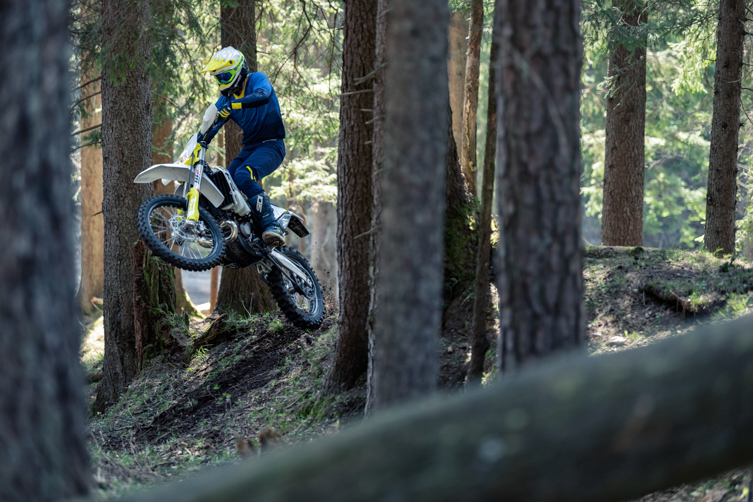
Like KTM, Husqvarna now sells more two-stroke enduro bikes than four-strokes. Do you think that’s got a lot to do with the fuel-injected two-strokes being more rideable?
When we first introduced the EFI to the two-strokes a coupe of years ago, it was a learning curve for us – a steep learning curve because Husqvarna and KTM were the first in the market to introduce it. We knew from the beginning that there was a huge opportunity to continue to develop the mapping for these models; to give riders the familiar feel they wanted from their two-stroke, but also to make them easier to ride fast. Compared with the carb bikes – which is how people still tend to define how their two-stroke ‘should’ feel – the EFI bikes’ fuelling inevitably makes them feel different. So while the EFI bikes do have their own power character – and massive advantages with things like emissions, fuel economy and throttle response – it’s fair to say that the development of our mapping has been driven to some extent by trying to replicate the feel of the carburetor bikes.

Despite the idiosyncrasies of the fuel-injected two-strokes – and a few glitches with the technology – the things have still sold like crazy around the world in the past two years.
They have. I think that there’s a few things at play there. Probably most importantly, this technology has re-engaged a lot of former two-stroke fans and made them realise there’s now the potential to get more power and adjustability from these two-stroke engines. Also, it took some time for riders to adapt their riding style to the fuel-injected bikes’ character. For 2020, the addition of the ambient air pressure sensor is a perfect example of where we’ve been able to refine the system to improve performance and rideability. At the factory’s R&D department, we now have a big taskforce of guys who work solely on EFI development, so the evolution of this technology and the bikes’ mapping is literally a constant process. Considering the technical challenges we faced by being the first to introduce this technology, I think we’ve now got the bikes working pretty well. And I’m sure we’ll get them to a completely flawless state in the next couple of years.
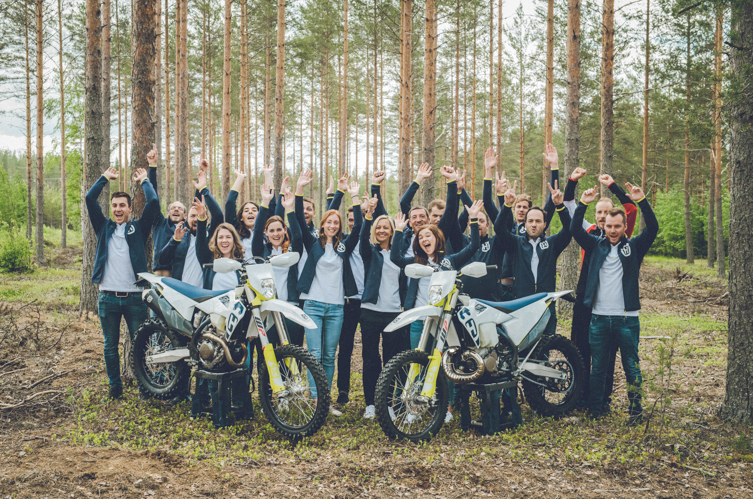
I know you prefer not to refer directly to your sister company, KTM. But the reality is, there’s a shared platform between the two brands. So just explain how the 600-odd people now in the company’s R&D department in Mattighofen are shared between Husky and KTM.
Yes, we’ve all heard people call Husqvarnas “white KTMs”. They probably don’t understand that both brands’ design teams individually define what they want out of their chassis and engines before the bikes go into development. Which means you could call KTMs “orange Husqvarnas” [laughs]. Seriously though, I’ll sit down with the KTM guys – in particular, with my equivalent at KTM, Joachim Sauer – and discuss which design elements we need to share. Then from that point, we move ahead and develop the bikes in the direction we want and change things accordingly. With Husqvarna’s enduro models, we have significantly more differentiation than with other products – largely because of the linkage we use on our enduro models, whereas KTM is very firm on keeping their no-linkage PDS shock set-up as it’s virtually their trademark. The linkage, and the set-up options it gives us, allows us to play a lot more with the feel of the bike. Additionally, our subframe gives the Husqvarna quite a different feel. So, there are some guys in the R&D department who work across both brands – the engine department guys, for example. Then with things like chassis development, the Husqvarna and KTM teams are completely separate. In other words, we develop the basic platform together – because it makes pure business sense to do this – and then go our own ways. The same thing applies to me with each brand’s product management and the marketing direction, etcetera. Of course, differentiating our product is something we’re all very passionate about and will continue to push.
“At the factory’s R&D department, we now have a big taskforce of guys who work solely on EFI development, so the evolution of this technology and the bikes’ mapping is literally a constant process.”
Looking at the upgrades for 2020, there’s obviously some common ground between the two brands, but probably less so this year than in the past.
I’d agree with that because we share the engine platform for 2020, but not a lot else. Because of the change to our linkage this year, our frames are also different to KTM’s. Plus our subframe, bodywork, seat and much of the other componentry – such as the clutch, brakes, handlebars, switchblocks, etcetera – is completely different.
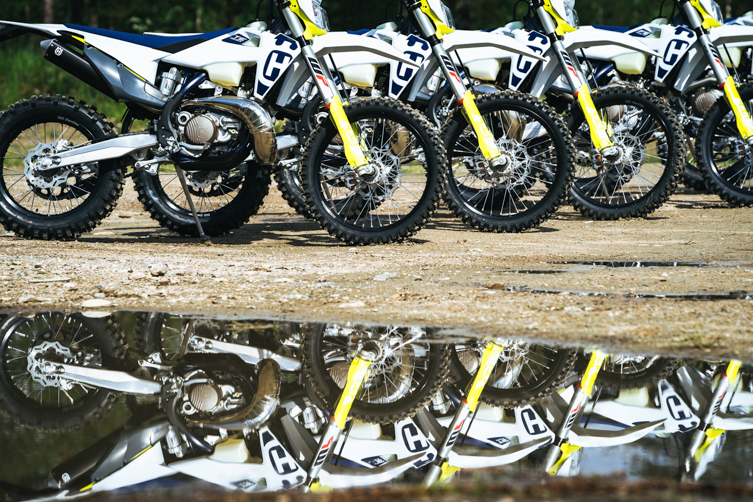
Given that your 2020 linkage effectively rakes the steering head angle out by almost 1º, would you say that resulting geometry change now represents the biggest ‘departure’ between the two brands?
Our 2020 enduro models have now gone back to using the same linkage as our motocross bikes. That has created a slightly lower seat and it changes the steering head angle by 0.7º. But, yes, even a geometry change of that magnitude is significant. I think the other standout change is our new two-piece subframe, which is now lighter and specifically designed with more flex to assist the shock absorber. As your body acts on the shock through the rear subframe, the subframe – no matter what material it’s made from – acts as an extension of the shock. The beauty of the polyamide and carbon material Husqvarna’s subframe is made from means we can better customise its flex character in the vertical plane, which gives the rider added comfort. Plus it’s designed to work more harmoniously with the flex of the main frame, and is way less inclined to bend than aluminium in a big crash.
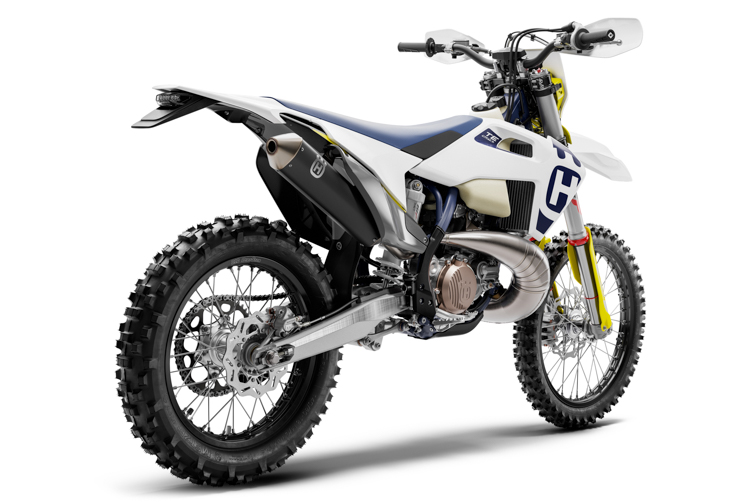
Was the lowered seat an intentional design, or just a consequence of the new linkage?
Both. The 2020 seat is 10 to 20mm lower than last year’s models, depending on where you take the measurement. At the front, it’s 10mm lower (this is made possible by the 12mm lower radiators and shrouds), and more like 20mm at the rear of the seat, where it’s additionally affected by the linkage change.
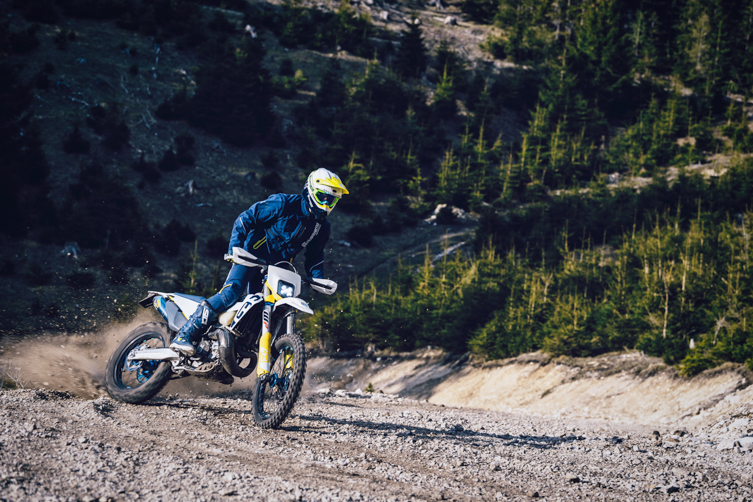
Okay, but was the new linkage fitted to create a more raked-out fork angle or only to lower the seat?
The linkage change was primarily an agility and control thing. We knew that the rear-end of our bikes were previously relatively high, and wanted to bring them lower so they were easier to ride – especially in technical and extreme terrain, where you’re at lower speeds; where you may need to paddle and appreciate that closer connection with the ground. People underestimate how big a benefit that is. Lowering the seat height was our main goal right from the very beginning, as we wanted to give riders the additional feeling of control that offers them. Our feedback from a greater majority of riders at the media launch was that they like the lower seat. Taller guys can always fit a higher seat from our accessories catalogue, or alter the linkage pull-rod to create a taller seat.
“There are some guys in the R&D department who work across both brands – the engine department guys, for example. Then with things like chassis development, the Husqvarna and KTM teams are completely separate.”
Sure, but the rolling chassis’ new geometry has an equally big impact on the 2020 bikes’ feel as the lower seat does, right?
It does, for sure. We found that the slightly slacker head angle with this year’s new linkage gives the entire chassis a more balanced feel from front to rear. And along with the added frame rigidity, this geometry change has given the 2020 bikes more stability. Similarly, by tilting the 250 and 300cc two-strokes’ engines 1º forward in the frame, we’ve achieved better front-to-rear balance and more feel and feedback from the front-end on those particular models.
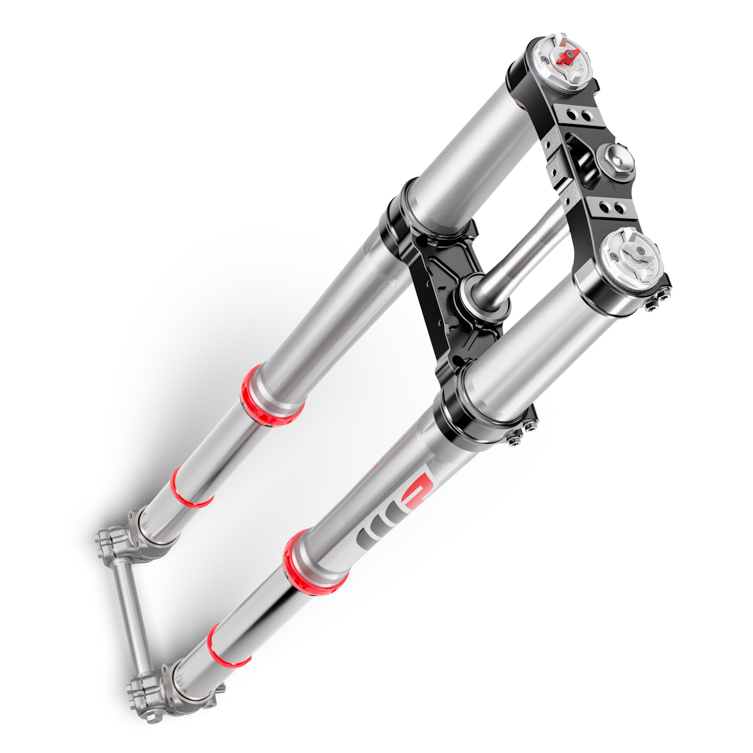
Obviously, you can’t talk about chassis changes without also making reference to the suspension. And the WP XPLOR fork, in particular, got significantly new settings for 2020, right?
Yes, it did. From an overall point of view, we’ve really focused on getting that first part of the stroke very supple on the 2020 bikes. This is key for rear wheel traction when accelerating, and for keeping the front-wheel in contact with the ground for braking and preventing any deflection off smaller bumps. But we’ve combined this with more progressive settings at both ends to make sure it also has very good bottoming resistance.
Like KTM did with its 2020 enduro range, Husqvarna’s 2020 FE and TE models get softer fork springs coupled with firmer damping. What’s the philosophy behind that?
We found that these fork settings best achieved our goals. The firmer compression damping in the fork helps it sit up in the plusher part of stroke better. And it controls the compression action of the fork more effectively through the entire stroke.

Coming back to the ergos, the new seat cover isn’t particularly grippy. In fact, it’s a bit slick.
Previously, when we used the diamond seat cover pattern – which we still use on our motocross bikes – the feedback we received it that it can be a bit rough on your bum on longer rides. Hence the move to a less aggressive pattern for 2020 on our enduro models. It’s not as slick as the one we used in 2013 and 2014, and let’s just say it’s been proven within the KTM/Husqvarna group [laughs]. For enduro and extreme, our test riders found that they could move around on the bike with this new pattern a lot easier. Sure, if you get a bit tired or lazy, the diamond pattern will help hold you in place on the bike, but it tends to leave its mark on you too. Once again, we have several accessory seat options available to suit people’s personal preference.
Or you could swap seats with a mate who owns a Husky MX model, right?
You could because the seat on our 2020 enduro and MX models is interchangeable. As is the bodywork and fuel tanks. Some components underneath the plastics – such as the tanks and electrics – are a little different between MX and enduro bikes, but the part numbers for each range’s plastics is literally the same. So the rider position and interface you now get on the 2020 enduro and MX models – other than the feel of the suspension and the way the chassis sits – feels very similar.
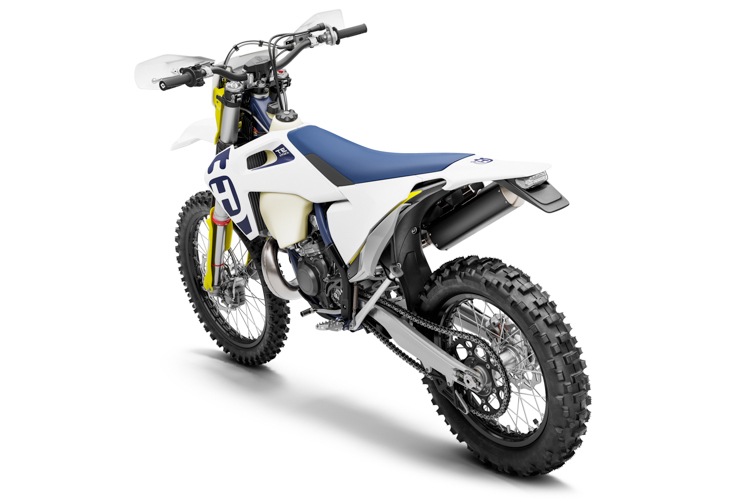
Speaking of plastics, ergos and rider interface, the 2020 bikes are narrower, but mainly though the rear-end, right?
The new bikes have roughly the same girth at the main contact points for your legs when standing, but they’re narrower through the sideplates and the radiator shrouds. The rear-end on the previous generation bikes was quite wide. Some liked that extra meat behind their knees to grab the bike; others didn’t. So we retained the contoured shape that helps hold the bike with your legs, but narrowed it down in the areas that allow the rider to move more freely back and forth on the bike.
“The beauty of the polyamide and carbon material Husqvarna’s subframe is made from means we can better customise its flex character in the vertical plane, which gives the rider added comfort.”
All the 2020 engines – two-stroke and four – felt torquier, more refined and easier to ride that their predecessors. It also felt like there was a bigger difference between the two map options.
Well, the main – or standard – map is still in constant development with our two-strokes. So that’s why you’ll tend to find a bigger difference between Map 1 and Map 2 on the four-stroke models. I think it’s also important to note that we’ve made an improvement to the traction control, which is no longer as intrusive. The previous settings retarded the ignition timing quite a lot and made too big an impact on the power delivery.
Do the changes made to all models’ exhaust systems also have a material effect on the power delivery for 2020?
There was an enormous amount of work on the exhaust systems for 2020. And, generally speaking, they all improve power and/or rideability, and help centralise mass. I think it’s fair to say that the ribbed expansion chamber and oval cross-section on the 250 and 300cc two-strokes stole the show in some respects. In addition to making it stronger, we also managed to make it more compact and offer better ground clearance. And as an added benefit, the ribbed shape helps dampen exhaust noise.

How’s the feedback been since the launch?
It’s been very positive, and that’s from riders of all abilities. I mean, Graham Jarvis won Erzberg this year on a 2020-model TE300i for us, which is about the most demanding test you can put a bike through. Right from the get-go, he said the 2020 bikes have come “miles forward” from their predecessors. Sometimes, improvements are perceived as only small refinements. But when you add several of them up, it makes a huge difference. So I think our design and development teams are rightfully very proud of what we’ve managed to achieve.
Worldwide, Husqvarna is now close to producing 50,000 units a year, which is kind of three times as many bikes as the brand was moving in 2014. Where to from here?
We’ve got very ambitious growth plans over the next few years. And we want to become Europe’s third biggest manufacturer. At the moment, KTM and BMW are number one and two in unit sales and/or revenue terms (though as a group, KTM and Husqvarna sell a lot more motorcycles in developing markets), after which you’ll find Triumph and Ducati. We think we still have a lot more growth potential with our off-road models – where we have great product, good marketing and lots of success in racing circles. But to achieve the sort of growth we’ve projected, we need to expand our street model offering. And we have a plan in place for that over the next 10 years. Then of course there’s the electric-assisted bicycles segment. Last year, in what was pretty much Husqvarna’s first year of producing these e-bikes, we sold 40,000 units, so we think there’s a huge opportunity there too. And finally, the e-mobility market is a major focus for us. Earlier this year, we launched our EE5 mini-cycle – our first electric off-road motorcycle – but there are a lot more projects that will ensure Husqvarna is at the forefront of urban mobility and the everyday transport people will be using in the future. Yep, always moving forward [laughs].
More on Husqvarna’s 2020 Range
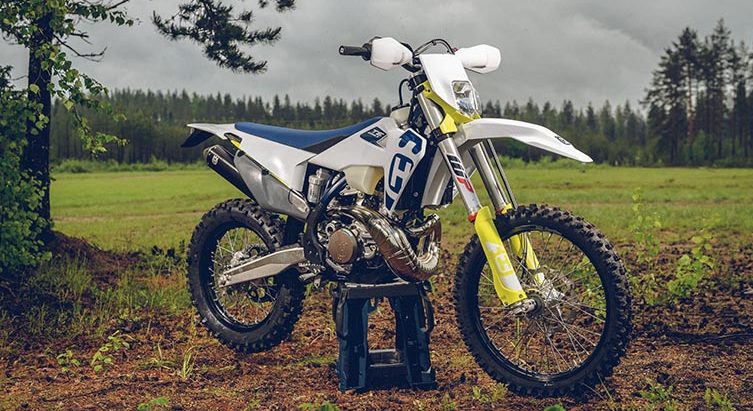
HUSQVARNA’S 2020 OFF-ROAD TOUR
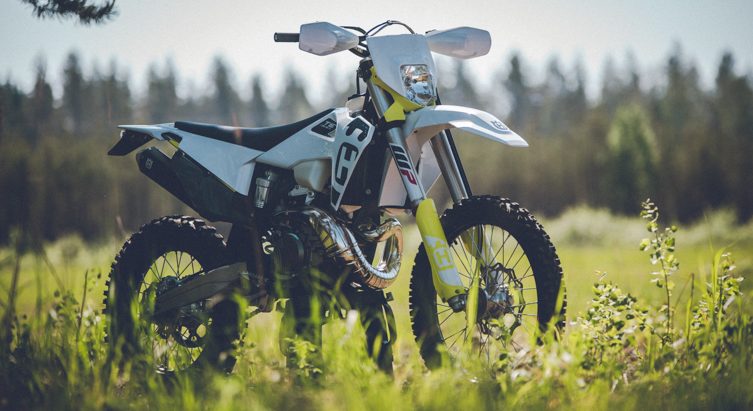
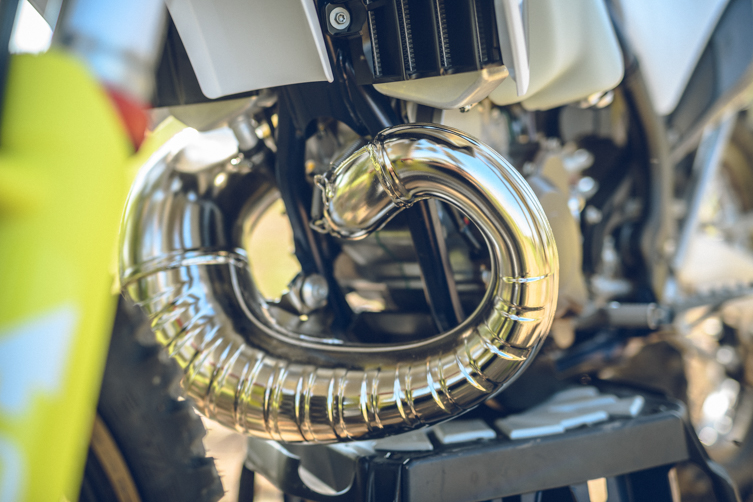
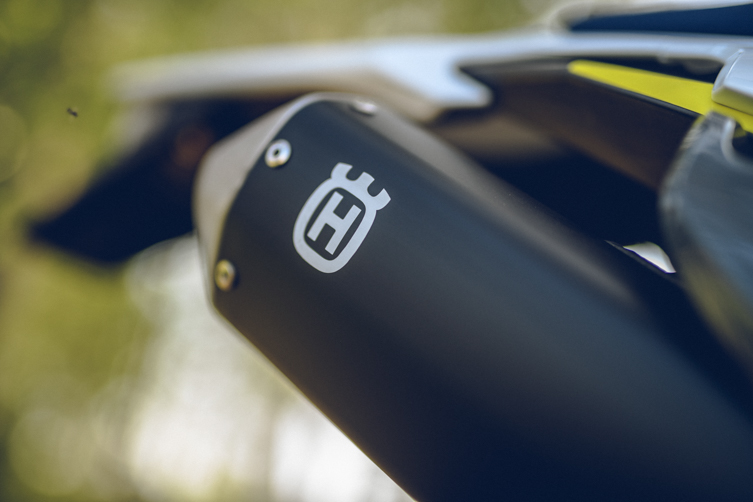




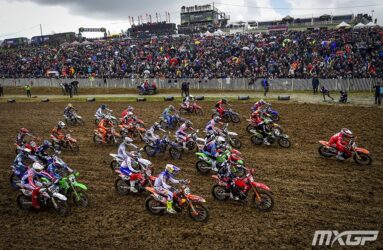

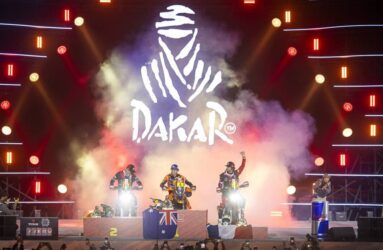
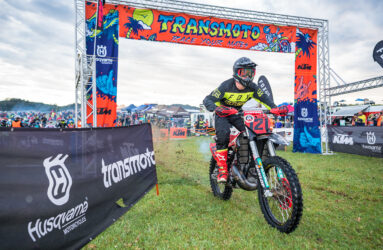


Be the first to comment...